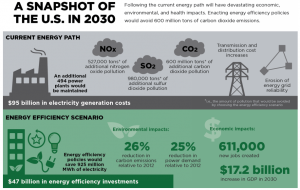Front Porch Blog
There’s an office on 14th Street N.W. in our nation’s capital with some smart folks who spend their days diving deep into energy data, giving us perspective on our energy policies, and making the case that saving energy can, as their website says, “lead to economic prosperity, energy security, and environmental protection for all.”
We say amen to that.
Last week, these folks at the American Council for an Energy-Efficient Economy (ACEEE) put out another of their scintillating reports, this one showing how the U.S. Environmental Protection Agency can apply energy efficiency as a key way to reduce global warming pollution — with no net cost to the U.S. economy.
The EPA is expected to release in early June its long-awaited, first-ever carbon dioxide pollution standard for existing power plants, the largest sources of carbon pollution in the U.S. ACEEE’s report, “Change Is in the Air,” shows that if the agency were to incorporate four common energy efficiency policies into its national policy, the U.S. could reduce carbon pollution by 26 percent below 2012 levels.
Doing so would substantially cut other kinds of air pollution too, like soot and smog, that pose a direct threat to our health. The four policies would reduce electricity demand by 25 percent, and avoid the need for 494 power plants.
That’s the green part. The gold part is this: adopting these four policies would increase national GDP by $17.2 billion, and create some 611,000 jobs across the country in about 15 years.
Every state — especially those in the South — has a vast opportunity to reduce wasted energy. Technologies for energy efficiency have been researched, developed and are raring to go. It’s simply a matter of political will and motivation, which the new carbon standard can provide. Including efficiency in the new carbon-pollution standard would allow states more flexibility in managing their energy portfolios.
The four policies ACEEE discusses are: 1) setting a state energy savings target of 1.5 percent per year; 2) implementing updated national model building codes; 3) constructing economically attractive combined heat and power facilities; and 4) adopting standards for five appliances.
And how is this good for everyone? The impacts of global climate change will undoubtedly be felt by virtually everyone on Earth sooner or later — including future generations to whom we have a moral obligation to leave a safe, healthy planet. A carbon standard that includes energy efficiency options is part of the solution.
By way of example, ACEEE focused on a few individual states including Virginia. Below is an excerpt:
In 2012 Virginia consumed over 107 million megawatt-hours of electricity (EIA 2013). Roughly 20% of its power was generated by coal-fired power plants. Nuclear power was responsible for over 42% of Virginia’s electricity, and about 35% was generated from natural gas. The state has 13 coal-fired electric generators with a total nameplate capacity of 5,770 MW.
Virginia’s electric power sector is responsible for over 35,975,000 tons of carbon dioxide per year, over 48,000 tons of nitrogen oxides, and more than 95,000 tons of sulfur dioxide. Its power plants emit the 28th highest amount of carbon dioxide in the country.
Virginia has the 10th largest economy in the nation based on gross state product
(usgovernmentrevenue.com 2014). Its unemployment rate was 5.5% in 2013 (BLS 2014b). While Virginia has made some progress, there is room for improvement when it comes to realizing significant economic and environmental benefits from its energy efficiency policies. The state has a voluntary savings target of 10% by 2022. However, because the standard is voluntary, it has become largely symbolic, with Virginia utilities saving only 0.1% in 2011. The state should implement a mandatory energy savings target to cover all electric generation. Virginia would also see significant benefits if it strengthened its model building codes and adopted standards for equipment not regulated by the federal government. While the state has adopted 2009 residential and 2007 commercial building energy codes, it does not have its own standards for equipment.What would these policy improvements do for Virginia? Together, these policies would avoid 17,000,000 tons of carbon dioxide in 2030, nearly $4,000,000 lost from missed work days and over 5,500 asthma attacks.35 They would also save money. The average cost of electricity in Virginia is currently estimated at around 9 cents per kWh. The policies would cost less per kWh, create new jobs in the state, and save
Virginia $2 billion in 2030.
PREVIOUS
NEXT
Related News

Leave a comment
Your email address will not be published. Required fields are marked *

